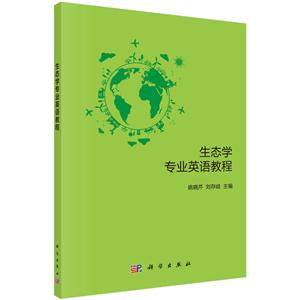生态学专业英语教程
本书特色
[
《生态学专业英语教程》共分为三大部分,**部分是生态学专业英语基础阅读,选编的文章根据生命系统结构层次进行分类,通过这部分的学习,读者能够掌握该领域的基本词汇和写作方法。第二部分是生态学专业英语提升篇,通过这部分的学习,不仅能够提高读者的阅读能力,而且能够使读者了解生态学研究前沿。第三部分是常用外文数据库介绍及SCI论文写作技巧,该部分结合案例详细地介绍了SCI论文各部分的写作技巧,并把作者发表论文中遇到的问题和积累的经验一并献给读者。
]
内容简介
[
《生态学专业英语教程》共分为三大部分,**部分是生态学专业英语基础阅读,选编的文章根据生命系统结构层次进行分类,通过这部分的学习,读者能够掌握该领域的基本词汇和写作方法。第二部分是生态学专业英语提升篇,通过这部分的学习,不仅能够提高读者的阅读能力,而且能够使读者了解生态学研究前沿。第三部分是常用外文数据库介绍及SCI论文写作技巧,该部分结合案例详细地介绍了SCI论文各部分的写作技巧,并把作者发表论文中遇到的问题和积累的经验一并献给读者。
]
目录
目录ContentsPart Ⅰ Base Components基础篇Unit 1 Autecology 3Lesson 1 Biotic and abiotic components 3Lesson 2 Soil supports diverse and abundant life 6Lesson 3 Plants exhibit adaptations to variations in nutrient availability 10Unit 2 Population ecology 13Lesson 4 Population size and density 13Lesson 5 Species distribution 16Lesson 6 Population dynamics 19Lesson 7 Life history theory 23Unit 3 Community ecology 26Lesson 8 The role of species within communities 26Lesson 9 Species with a large impact on community structure 29Lesson 10 Effects of biogeography on community diversity 35Lesson 11 Ecological succession 38Unit 4 Ecosystem ecology 41Lesson 12 Energy flow in ecosystems 41Lesson 13 Biogeochemical cycles 45Lesson 14 Ecosystem dynamics 50Lesson 15 Ecosystem services 52Lesson 16 Evolution and natural selection in ecosystems 55Unit 5 Global change ecology 59Lesson 17 Global change: an overview 59Lesson 18 Human impact and ecosystem degradation 63Lesson 19 Impacts of global change on human society 66Lesson 20 Biodiversity and climate change 69Lesson 21 Global climate change and risk assessment: invasive species 73Part Ⅱ Promotion Components提升篇Unit 6 Studies on autecology ecology 79Lesson 22 Growth and yield stimulation under elevated CO2 and drought:a meta-analysis on crops 79Lesson 23 Mycorrhizal associations of trees have different indirect effects on organic matter decomposition 81Lesson 24 Effects of enhanced UV-B radiation on the nutritional and active ingredient contents during the floral development of medicinal chrysanthemum 84Lesson 25 Interactive effects of temperature and pCO2 on sponges: from the cradle to the grave 86Lesson 26 Salinity influences arsenic resistance in the xerohalophyte Atriplex atacamensis Phil 90Unit 7 Studies on population ecology 93Lesson 27 Climate, invasive species and land use drive population dynamics of a cold-water specialist 93Lesson 28 Does movement behaviour predict population densities?A test with 25 butterfly species 95Lesson 29 Anthropogenic-driven rapid shifts in tree distribution lead to increased dominance of broadleaf species 97Lesson 30 Species’ traits influenced their response to recent climate change 99Lesson 31 Genetic diversity affects the strength of population regulation in a marine fish 101Unit 8 Studies on community ecology 105Lesson 32 Levels and limits in artificial selection of communities 105Lesson 33 Effects of temperature variability on community structure in a natural microbial food web 109Lesson 34 Size-balanced community reorganization in response to nutrients and warming 113Lesson 35 Functional trait diversity across trophic levels determines herbivore impact on plant community biomass 116Lesson 36 Resource pulses can alleviate the biodiversity-invasion relationship in soil microbial communities 119Unit 9 Studies on ecosystem ecology 122Lesson 37 Energy flows in ecosystems—relationships between predator and prey biomass are remarkably similar in different ecosystems 122Lesson 38 Diversity increases carbon storage and tree productivity in Spanish forests 125Lesson 39 Biodiversity effects on ecosystem functioning change along environmental stress gradients 128Lesson 40 Disturbances catalyze the adaptation of forest ecosystems to changing climate conditions 130Lesson 41 Elevated CO2 and temperature increase soil C losses from a soybean-maize ecosystem 133Unit 10 Studies on global change ecology 136Lesson 42 Mycorrhizal status helps explain invasion success of alien plant species 136Lesson 43 Genetically informed ecological niche models improve climate change predictions 139Lesson 44 Nitrogen deposition and greenhouse gas emissions from grasslands: uncertainties and future directions 141Lesson 45 Climate change is not a major driver of shifts in the geographical distributions of North American birds 145Lesson 46 Temperature impacts on deep-sea biodiversity 147Part Ⅲ An Introduction to Commonly Used Foreign Language Databases and Writing Skills for SCIPapers常用外文数据库介绍及SCI论文写作技巧Unit 11 SCI及常用外文数据库介绍 153Lesson 47 SCI简介 153Lesson 48 常用外文数据库及介绍 155Lesson 49 数据库使用方法介绍 160Lesson 50 百链云服务平台简介 163Unit 12 SCI期刊论文写作技巧 167Lesson 51 退稿的常见原因 167Lesson 52 SCI期刊论文写作前的准备及基本框架 171Lesson 53 题目、作者及通讯地址 174Lesson 54 摘要和关键词撰写技巧 177Lesson 55 前言写作技巧 179Lesson 56 材料与方法撰写技巧 182Lesson 57 结果、讨论和结论撰写技巧 185Lesson 58 致谢和参考文献撰写技巧 190Lesson 59 期刊选择技巧 193Lesson 60 SCI期刊论文投稿时需要的内容 196References 199Appendix 205Appendix Ⅰ 常见生态学专业词汇 205Appendix Ⅱ 生态学学科SCI收录期刊简介 213
封面

书名:生态学专业英语教程
作者:姚晓芹
页数:215页
定价:¥42.0
出版社:科学出版社
出版日期:2017-12-01
ISBN:9787030536037
PDF电子书大小:155MB 高清扫描完整版
